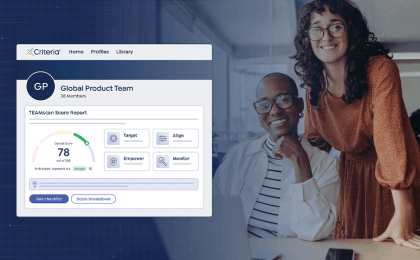More than ever before, employee experience matters to talent professionals who are tasked with recruiting and retaining great employees. In fact, according to LinkedIn’s latest Global Talent Trends report, 94% of talent professionals agreed that employee experience (EX) is crucial to the next frontier of human resources.
Here are some of the most frequently asked questions about 2020’s top talent trend—which, by the way, is almost certainly here to stay.
What is employee experience?
Employee experience (EX) refers to every little thing an employee feels and observes during their journey with a given company. Employee experiences happen at every company and for every worker, whether that employee commutes to the headquarters of a Fortune 500 corporation or works remotely for a tiny startup.
The main goal of employee experience is to understand just how employees function, and then create an employee experience for them that fosters productive, exemplary, and satisfying work.
Of course, happy and productive employees require good management, opportunities for growth and learning, and attractive compensation. But employee experience is about more than that, too.
Employee experience pushes HR professionals to think holistically about, well, everything. This includes considering an employee's relationships with coworkers and clients, the physical environment where the employee works, the very work employees do, and the guidelines and strategies for getting that work done. (LinkedIn’s report smartly refers to this four-part EX framework as “The Four P’s”: people, place, product and process.)
What does employee experience accomplish?
Employee experience isn’t just an HR buzzword. It really matters. Companies are pouring time, money and resources into employee experience because it improves employee retention, boosts productivity, and attracts both more and better quality prospects.
Many companies are willing to devote seemingly endless resources into customer experience (CX), but balk at spending big bucks on employee experience. But there seems to be convincing evidence that investing in EX can make a company even more profitable.
There are a number of studies that indicate that a positive employee experience yields increased involvement, enthusiasm, and engagement from workers. One analysis of 250 organizations revealed that businesses that invest in EX are four times as profitable as businesses that do not.
How can I improve employee experience?
There are many different ways to improve employee experience, but they all have one thing in common: they put the employee first.
Solicit and gather employee feedback, then analyze it and take it to heart. Use your findings to journey map your employees’ experiences through your organization. Are there any moments during which they are unsupported? Address those shortcomings genuinely, with the same energy and resources you would call upon to solve problems for your customers, clients, and other stakeholders.
You may also want to implement “stay” interviews. Exit interviews are great, but they can be too little, too late. Stay interviews offer talent professionals the opportunity to uncover and address an organization’s shortcomings before a valued employee takes their talents elsewhere.
Training your mid- and high-level managers to boost employee experience is also essential. While change at the very top is great, keep in mind that many, many employees may have little to no interaction with your organization’s leaders, especially if your company is large. A mid-level manager may very well be the face of your business to the bulk of your employees. So don’t just train your executives to tinker with employee experience. Empower local leaders to make improvements to EX, too.
Worth noting: While EX might be top of mind for just about every company nowadays, not every business is doing it right. Just about half of human resources personnel believe their company is offering a net-positive employee experience. Make sure you’re doing everything you can to champion employee experience.
Should I hire someone to handle employee experience?
Maybe. Since 2014, LinkedIn has reported a 2.4x increase in members whose positions include the term “employee experience.” For example, Netflix is hiring a Workplace Experience Manager in Los Angeles, and Amazon is hiring an Employee Experience Program Manager in Seattle.
Even if you decide hiring a dedicated employee experience professional isn’t best for your business, you will want your current human resources personnel to study up on EX. That way, your current team can ensure your company is offering an excellent—and constantly improving—employee experience.
You can always reskill and retrain loyal employees (yourself included!) to emphasize employee experience.
Mark Levy, Chief Human Resources Office at Airbnb, changed his title to Chief Employee Experience Officer in 2015. This was a measured decision that emphasized the company’s commitment to creating memorable experiences not just for their customers, but also for their employees. Airbnb does this through a variety of programs and initiatives, including providing globally-inspired food, offering paid time off to volunteer locally, and championing authentic communication between employees at any and every level.
It’s up to you, your human resources team and your company’s leaders to determine whether your organization would benefit from hiring somebody to manage employee experience. No matter what you decide, one thing is clear: employee experience should not be ignored. Find a way to make it a priority, as soon as possible.
How can I tweak my company’s hiring process itself to boost employee experience?
The answer is quite simple: hire people who are different from one another!
One Forbes article suggests that employee experience can be improved upon by hiring more diverse employees. The piece points to a study that revealed that more diverse, inclusive workplaces boosted employee engagement, creativity, and sense of belonging—all while decreasing that dreaded intent to leave a company.
To hire more diversely, treat prerequisites like guidelines, not hard-and-fast rules. Turn to pre-employment testing to reduce unconscious bias from your hiring process. Write more inclusive job descriptions that steer clear of inherently sexist modifiers in your job postings; for example, a “polite and charming hostess” or an “IT ninja” are both stereotypically-charged and gender-biased.
You’ll also want to perform structured interviews, so that all applicants—especially ones who are different from you—are given a chance to shine. Finally, post your employment opportunities in different places. If your recruiter keeps bringing you prospects who all look, talk, act, and solve problems the same way, you might want to change things up.
As you make organizational changes to boost employee experience, keep in mind that your work on EX will never be truly done. Like all the most challenging projects, employee experience initiatives will only grow more complex—and more necessary—as more organizations begin to prioritize it.





